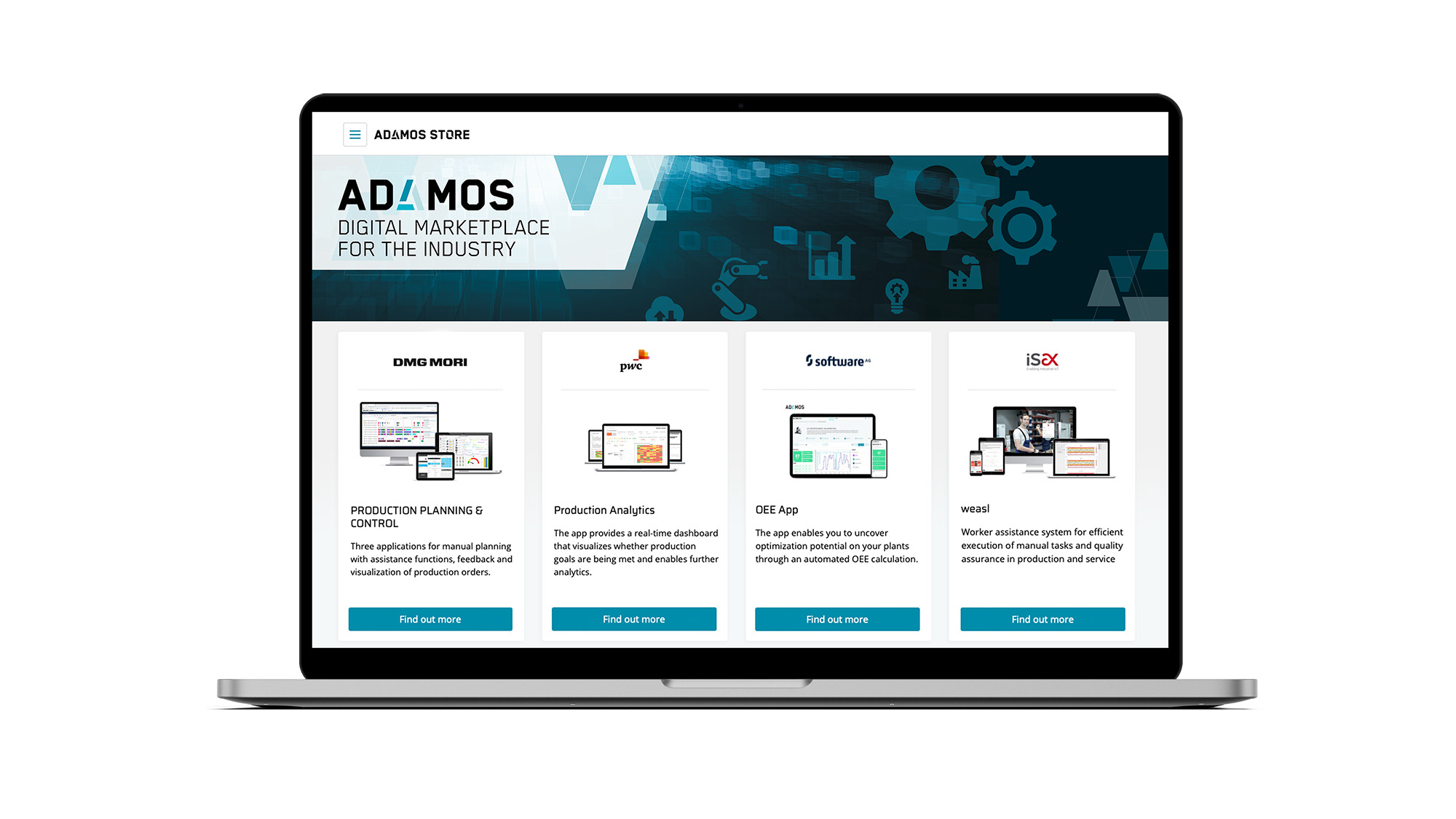ADAMOS was founded as a strategic alliance for the future topics of Industry 4.0 and the Industrial Internet of Things (IIoT). ADAMOS stands for ADAptive Manufacturing Open Solutions and is the first alliance of global market leaders in mechanical and plant engineering.
ADAMOS is specifically tailored to the needs of the mechanical and plant engineering industry and its customers. With innovative solutions and offerings, ADAMOS is actively driving digitalization for mechanical engineering.
Easy Engineering: What are the main areas of activity of the company?
ADAMOS: ADAMOS sets standards for the mechanical and plant engineering industry by offering unique and integrated solutions. With ADAMOS STORE, a digital marketplace and ADAMOS HUB, an integration platform, ADAMOS offers the first open, vendor-neutral industrial marketplace for digitally pre-integrated products.
The ADAMOS STORE is an industrial marketplace for digital products and apps. Following the slogan B2B like B2C, it offers end customers a customer experience known from private life. Customers of machine builders find, test, buy and use digital products all in one place. Ordering digital B2B-products has never been easier, thanks to standardized checkout and billing processes.
The ADAMOS HUB is part of the ADAMOS STORE. The ADAMOS HUB enables the exchange of defined machine data with apps from different providers, thus offering cross-platform and cross-vendor management in one system. For users the ADAMOS HUB has two areas: myApps and Control Center. Via ‘myApps’, users control all purchased and subscribed apps. The administration and control of used data is managed via the data management in the ‘Control Center’. The ecosystem significantly contributes to the harmonization of digital products on the shopfloor.

E.E: What’s the news for 2021 about new products?
ADAMOS: The adequate provision of digital solutions and the expertise is really important to reduce entry barriers. This is exactly what we achieve with the ADAMOS STORE. Here, we focus on apps with an industry focus, opportunities to test software and a simple customer experience from booking to billing.
The ADAMOS STORE as a digital marketplace for apps, services and hardware as pay-per-use models has been available since summer 2021. Since then, solution providers are implementing their apps in the ADAMOS ecosystem.
Especially for small and medium-sized companies, standardized marketplaces including free trial offers for software solutions are enormously important. Through trial offers we give customers a better basis for decision-making and minimize the entry barriers in order to make digital software solutions usable for the shopfloor.
E.E: What are the ranges of products?
ADAMOS: ADAMOS is tailored specifically to the needs of the mechanical and plant engineering industry and its customers. The target is to enhance the expansion of the “digital factory” among customers. Producing companies are able to buy or subscribe apps and other services with just a few clicks. The range of products focusses on any type of industrial solutions as Software-as-a-Service or Equipment-as-a-Service offering.
E.E: At what stage is the market where you are currently active?
ADAMOS: For both providers and customers in the industrial sector, the economy of platforms and marketplaces offers great opportunities. Especially medium-sized companies can benefit from new marketplace offerings. But B2B marketplaces must have a higher degree of specialization than B2C marketplaces. While the B2C sector is primarily concerned with price and convenience, B2B-customers put particular value on quality, reliability, consistency and data security. Additionally, the topic of integration of different solutions and machines is crucial.
Currently, there is no directly comparable solution. We have an absolutely unique selling proposition. There are other initiatives in the industrial environment, but while they are still planning, we are already in the market and are sending out a clear message for collaborative innovation.
E.E: What can you tell us about market trends?
ADAMOS: Mechanical and plant engineering is the backbone of industry and therefore a relevant sector. However, due to a lack of standards, a high degree of heterogeneity and complex supply chains, it is hardly digitized. But our experience is that theory is more intimidating than reality. There is a large number of good software solutions that deliver immediate added value. The example of “up2parts” available through the ADAMOS STORE is one such solution. With this software, companies manage to calculate and produce customer-specific quotations extremely quickly, based on CAD drawings and past quotations. Companies that look at this solution are quickly convinced.
E.E: What estimations do you have for 2022?
ADAMOS: The Corona pandemic has made a big push by catapulting digitalization into reality. Sustainable business models, real innovations, future oriented work and production processes – all this is being experienced or at least piloted right now. The industry is increasingly recognizing the added value of digitization and is losing its fear of digital transformation to the same extent. Companies now know well how to differentiate where to enter digitally and achieve success, and then tackle digital innovations step by step.
Additionally, we are seeing a rise of subscription business. Not only in the software business, but also for equipment. The “subscription economy” is a topic that the management in many industry companies is considering. Particularly because usage-based payment has become essential for company survival, especially in the pandemic.
Examples for new scenarios are:
- Pay-per-hour: billing according to time of use (machine running time),
- Pay-per-part: billing according to quantity produced (e.g. number of pieces of a component produced),
- Pay-per-page: Billing according to printed sheets of paper (printing press industry),
- Pay-per-unit: billing according to unit of quantity consumed (e.g. cubic meters of compressed air consumed))


